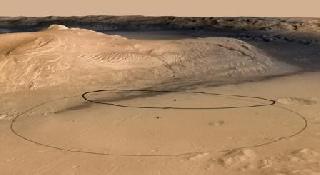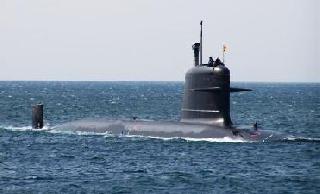
This image shows changes in the target landing area for Curiosity, the rover of NASA's Mars Science Laboratory project. Photo: NASA/JPL-Caltech/ESA/DLR/FU Berlin/MSSS.
WASHINGTON (AFP): NASA's Mars rover, nicknamed Curiosity, is zeroing in on its August landing on the Red Planet and aims to touch down closer than expected to its mountain target, the US space agency said.
With a mission to use its roving toolkit to drill for signs that microbial life may have once existed on Mars, the rover is now set to land about four miles closer to the mountain than initially planned.
The car-sized rover, which NASA scientists have described as a 2.5-billion-dollar dream machine, launched from Florida in November 2011, and aims to land in Mars' Gale Crater at 0531 GMT on August 6.
"We're trimming the distance we'll have to drive after landing by almost half," said Pete Theisinger, Mars Science Laboratory project manager at NASA's Jet Propulsion Laboratory in Pasadena, California.
"That could get us to the mountain months earlier," he said, adding possibly as many as four months earlier than planned.
However, the narrower landing ellipse -- now four miles wide by 12 miles long instead of 12 miles wide and 16 miles long --- also brings the vehicle closer to the potential danger of coming down on a slope of Mount Sharp instead of a flat surface in the Gale Crater.
The six-wheeled rover will be lowered onto Mars with the help of a rocket-powered sky crane, and is carrying a sophisticated toolkit for rock sample analysis to support its two-year (one Martian year) mission.
Lab analysis has shown that one of its drills may contaminate Mars rock samples with bits of Teflon, a problem that was discovered shortly before launch, NASA said.
"We are getting a greater understanding of that contamination issue. The testing so far continues to give us reasonable confidence that we will be able to meet all mission success criteria for the use of the drill," said Theisinger.
Mars Science Laboratory project scientist John Grotzinger told reporters that since this is the first time a Mars rover has carried a drill, scientists are learning from the experience.
"We don't have enough information yet to really know how serious the problem is," he said, adding, "we see so many potential ways to work around this that we could use."
Three other orbiters -- already circling the Red Planet -- are being positioned to be overhead when the rover approaches Mars so they can relay communications back to Earth.
 Previous Article
Previous Article Next Article
Next Article













The Indian Air Force, in its flight trials evaluation report submitted before the Defence Ministry l..
view articleAn insight into the Medium Multi-Role Combat Aircraft competition...
view articleSky enthusiasts can now spot the International Space Station (ISS) commanded by Indian-American astr..
view article